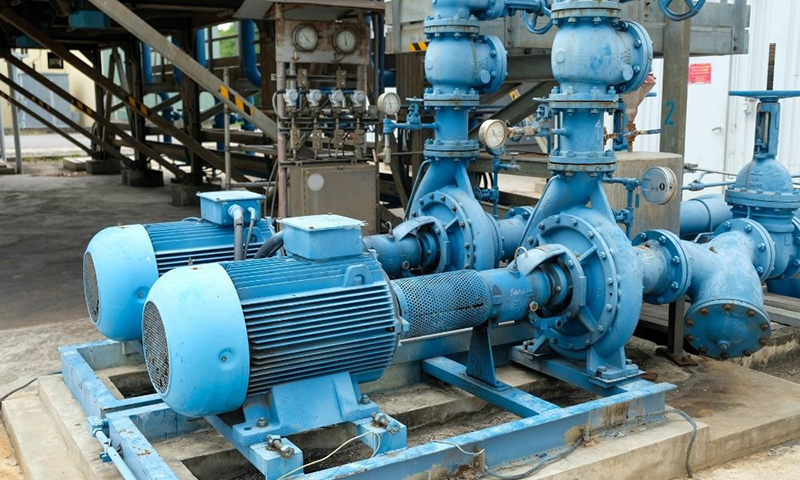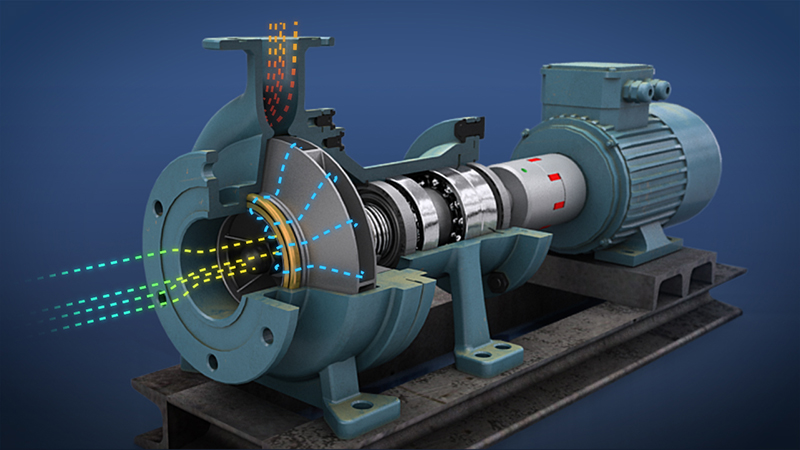Centrifugal pump impellers play a significant role in thermal power plants, water treatment plants, the chemical industry, and more. They are designed to enhance the pressure and velocity of fluids pumped by centrifugal pumps. The impeller is a curved rotating blade that generates a spiral flow, resulting in an outward force that propels the liquid at higher speeds and with greater force than it would naturally flow.
By spinning rapidly in a circular motion, the blades create a whirling effect that amplifies the fluid’s movement and improves the pump’s efficiency. For example, in thermal power plants, centrifugal pump impellers are instrumental in boosting the circulation of cooling water, which helps regulate temperature levels in the system.

What Is An Open Impeller Pump?
Devices with connected vanes and a hub positioned on a shaft are known as open impellers. Impellers that are accessible have a little lower efficiency than those that are closed or semi-closed.
As the side plate is not attached to the inlet, the spiral design provides a functional benefit in reducing blade pressures. However, the vane design has a design benefit in reducing blade stresses because the side plate is not connected to the intake. The fluid flows into the pump through the inlet but is redirected to the impeller’s eye, where vanes add speed and send it to the nozzle outlet.
The clearance between the bowl and vanes can be adjusted in open impellers to account for wear & tear to maintain the pump’s efficiency over time. Open impellers in pumps are easier to inspect and maintain due to their visible parts. They can also be easily modified for different requirements. Open impellers are generally faster to maintain and operate at specific speeds. Open impellers are often preferred for solids or small pump applications as they are less prone to sand locking.

What Is A Closed Impeller Pump?
The closed impeller pump is designed with added wall sections on the front and back of its vanes, which increases its strength and decreases the thrust load on the shaft. As a result, it offers longer bearing life, improved reliability, and reduced shafting costs. However, the closed impeller is more intricate to manufacture and expensive than the open impeller. In addition, an increase in the wear ring clearance causes a reduction in the efficiency of the closed impeller. Unlike open impellers, closed impellers perform well at a broader range of speeds but are unsuitable for pumping solids. If the impeller becomes clogged, cleaning becomes difficult. Closed impellers are mainly used in large-scale pumps for precise water applications.
When purchasing an industrial centrifugal pump, it’s essential to prioritize high efficiency, low maintenance, and reliable performance. However, while these factors are crucial, people often need to pay more attention to selecting the appropriate impeller style for their pump. Previously, impellers were categorized into open and closed types, but nowadays, a semi-open impeller is a third option. The open and closed impellers have several distinctions, which are listed below:
-
- Closed impellers are popular in various industries because they are suitable for handling volatile and explosive fluids. The design allows for a tight seal that prevents hazardous fluid leakage. Furthermore, closed impellers can produce higher pressure and head than open impellers, making them ideal for high-pressure pumping applications.
- The efficiency of a closed impeller is exceptionally high at the initial stages, but it gradually declines over time due to the increase in clearance of the wear ring. This clearance is created when the impeller’s vanes wear down over time, creating a gap between the wear ring and the impeller’s edge, reducing efficiency.In contrast, open impellers can maintain their efficiency through regular clearance adjustments, which can be done by moving the impeller back or forth in its casing. This ensures that the impeller remains near the wear ring, enabling it to maintain high levels of efficiency even over an extended period.
- When checking the status of wear rings, closed impellers require the pump to be disassembled, which can be time-consuming. In addition, the worn ring is inside the pump’s casing, making it difficult to access without taking it apart.On the other hand, open impellers eliminate the need for pump disassembling since the wear rings are located outside the impeller, making them easily visible and accessible for inspection. This saves time and reduces maintenance costs associated with dismantling the pump.
- An open impeller has vanes attached to a central hub, but any housing or shroud does not enclose them. This design allows for more space between the vanes, which reduces the likelihood of clogging when pumping fluids that contain solids or stringy materials. In contrast, a closed impeller pump has fully enclosed vanes by housing or shroud, which can lead to clogging if solids or stringy materials get trapped between the vanes and the housing.
- Conversely, cleaning a closed impeller can be more complex because the vanes are fully enclosed and harder to access. This can result in downtime for maintenance and repairs, which can be costly for businesses that rely on pumping equipment.
- Regarding speed, the closed impeller has limited speed choices. It also has a more complex design, which makes modifications difficult. This is because the impeller is enclosed within a casing, and any changes to the vanes would require disassembling the entire pump.Conversely, an open impeller has a simple design allowing easy modifications to its vanes. For example, the vanes can be cut to increase the capacity or change the flow characteristics of the pump. Additionally, open impellers have a wide range of specific speed choices, which allows for more flexibility in selecting the best impeller design for a particular application.

The distinction between open and closed impellers of Centrifugal pumps by JEE pumps is application-specific. Therefore, it is important to consider the intended application while choosing the impeller type for your centrifugal pump. In addition, when making a pump purchase decision, factors like efficiency, maintenance, and reliability must be given priority. Pay attention to these essential aspects to avoid future regrets, like buying a car with poor mileage. Therefore, considering these factors while selecting the impeller type can ensure an informed decision and avoid future regrets.
Conclusion
The difference between open and closed impellers in centrifugal pumps lies in their design and functionality. An open impeller has vanes not covered by a shroud, allowing solids to pass through the impeller without clogging. It is ideal for handling fluids with high solids, making it a popular choice in wastewater treatment plants and mining applications. On the other hand, a closed impeller has vanes that are fully covered by a shroud, resulting in higher efficiency and lower maintenance. It is suitable for fluids with low solids and high flow rates, making it a preferred choice in industrial processes and water treatment facilities.


